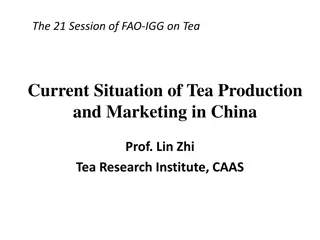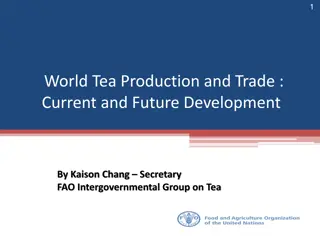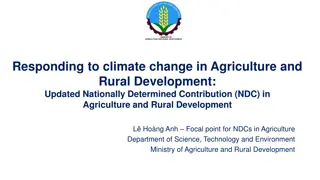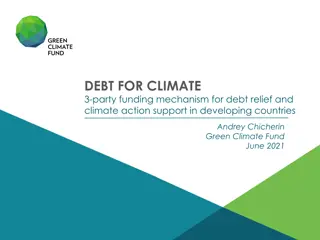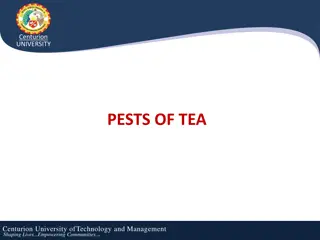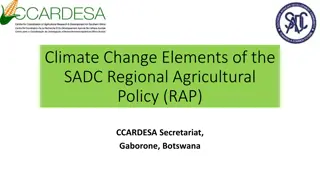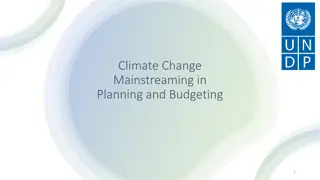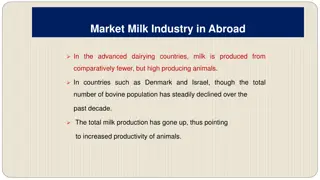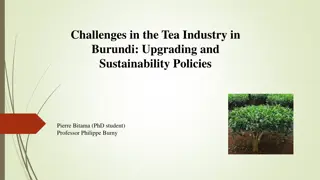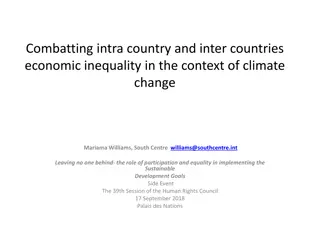Socio-Economic Implications of Climate Change for Tea-Producing Countries
The socio-economic implications of climate change for tea-producing countries are significant, affecting both the estate and smallholder sectors. With tea being a crucial cash crop for rural development and poverty alleviation, the impact of climate change on the world tea market is substantial. This necessitates adaptation measures for tea cultivation to mitigate risks and ensure sustainability in the face of changing climatic conditions.
Download Presentation

Please find below an Image/Link to download the presentation.
The content on the website is provided AS IS for your information and personal use only. It may not be sold, licensed, or shared on other websites without obtaining consent from the author. Download presentation by click this link. If you encounter any issues during the download, it is possible that the publisher has removed the file from their server.
E N D
Presentation Transcript
Socio- economic implications of climate change for tea producing countries
Outline Introduction Implication of climate change for tea Socio-economic implications The estate sector The smallholder sector Impact of climate change on the world tea market Adaptation measures for tea cultivation Conclusions
Introduction Document CCP:TE 14/4 uses information to assess some socio-economic implications for tea producing countries Mitigation = attempts to reduce greenhouse gas emissions at their source Adaptation = attempts to reduce vulnerability to climate change
Implication of climate change for tea Tea is: Important cash crop Plays a significant role in Rural development Poverty alleviation Food security Planted in 58 countries 3.36 million hectares under tea cultivation (2012) 4.78 million tonnes produced (2012)
Implication of climate change for tea (cont d) Comparative growth rates in area and yield in Sri Lanka (1985-2013) 55 50 45 40 35 30 25 20 percent 15 10 5 0 -5 -10 -15 -20 -25 -30 1984 1986 1988 1990 1992 1994 1996 1998 2000 2002 2004 2006 2008 2010 2012 2014 area yield
Implication of climate change for tea (cont d) Comparative growth rates in area and yield in Kenya (1985-2013) 40 35 30 25 20 15 percent 10 5 0 -5 -10 -15 -20 1984 1986 1988 1990 1992 1994 1996 1998 2000 2002 2004 2006 2008 2010 2012 2014 area yield
Implication of climate change for tea (cont d) Comparative growth rates in area and yield in China (1985-2013) 35 30 25 20 15 10 percent 5 0 -5 -10 -15 -20 -25 1984 1986 1988 1990 1992 1994 1996 1998 2000 2002 2004 2006 2008 2010 2012 2014 area yield
Implication of climate change for tea (cont d) Implications of climate change: Dry soil top if mulching is not applied Increased incidence of new pests and diseases More carbon dioxide being released into the atmosphere through deforestation Reduced or uncertain rainfall patterns and limited ground and river water Main issues include of tea s environmental footprint: Reduced biodiversity and ecosystem function High energy consumption High application of pesticides in some countries.
Implication of climate change for tea (cont d) Nominal and real prices of tea 350.00 300.00 FAO Composite Price 250.00 (US cents) 200.00 Nominal Prices 150.00 Real Prices 100.00 50.00 0.00 1985 1990 1995 2000 Year 2005 2010 2015
Socio-economic implications: the estate sector Issues estates are facing: Erosion of top soil Increased use of fertilizers Increased usage of pesticides Addressing longer dry seasons and heavier rains
Socio-economic implications: the estate sector Increasing costs of mitigating climate change raise serious socio-economic issues: Low wages and low-quality housing Health and safety Declining workforce Casual or short-term employment Gender discrimination Diminishing workers representation
Socio-economic implications: the smallholder sector Change in supply structure from large plantations to smallholders Smallholders in Sri Lanka responsible for 76% of total production Smallholders in Kenya responsible for 62% of total production Issues constraining smallholders: Low farm gate prices Poor extension services Limited market channels Little or no access to credit Low level of farmer organization. Changes in weather patterns: Possible income loss due to decrease in plucking days (G. Boriah, Tea Board of India).
Impact of climate change on the world tea market Blending, packing and marketing of tea are the most profitable and controlled by a handful of multinational tea packers and brokers Real prices for tea on the shop shelves have not increased over time but have in nominal terms. Average real auction prices between 2000-2008 roughly half of those in the 1980s Auction prices have increased somewhat since 2008. Challenges for most producing countries: Capturing value addition in tea supply chain Increasing quality Rising costs to meet food safety standards Sri Lanka, India and Kenya successful in capturing value addition
Impact of climate change on the world tea market (cont d) Table 1. Climate change scenario Impact at the world level Average percentage change between baseline and simulation Price 26.3 Consumption -3.3 Production -3.4 Export 2.3
Impact of climate change on the world tea market (cont d) Impact of climate change on the world tea prices (USD/kg) 5 4.5 4 3.5 3 2.5 2 1.5 Simulation Baseline 1 0.5 0
Adaptation measures for tea cultivation Adaptation measures recommended by the Working Group on Climate Change: Planting drought and stress tolerant tea cultivars Diversifying production Intercropping tea with other tree crops Organic cultivation Water conservation
Conclusions Evidence that GHGs are causing global warming and climate change Climate change will have a significant impact on future tea production Several uncertainties are not yet fully understood: Frequency of natural disasters The proliferation of certain pests and diseases Higher infrastructure cost. Recommendations: Agricultural and socio-economic adaptation strategies are required in the short term Tea producing areas should be evaluated against climate projections Comparative studies are necessary Possibility of breeding special tea hybrids that cope better with climate change should be considered A competitive environment for tea production and processing safeguarded by governments could create long-term socio-economic and environmental sustainability that will help mitigate the impact of climate change







